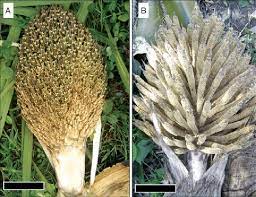Complete Guide on How to Grow Arrowroot
In this article, we will be discussing about how to grow arrowroot, but first, what is arrowroot? Arrowroot (Maranta arundinacea) is a tropical tuberous plant that has been cultivated for centuries due to its culinary and medicinal properties. In this comprehensive description, we will explore the various facets of arrowroot, including its botanical characteristics, cultivation practices, nutritional value, and versatile uses.
Arrowroot is an herbaceous perennial plant native to South America, particularly the Amazon rainforest region. It belongs to the Marantaceae family and is closely related to other plants like turmeric and ginger. The plant typically grows to a height of 2–5 feet and boasts lush, broad, lance-shaped leaves with prominent veining.
The arrowroot tuber is the primary point of interest. It is a starchy, fleshy underground rhizome, resembling a carrot in shape and size, though typically smaller. The tuber’s skin is smooth and varies in color from cream to pinkish-red, while the flesh is white with a neutral flavor and a unique mucilaginous texture when grated. Growing arrowroot requires a tropical to subtropical climate with consistent rainfall and well-drained, slightly acidic soils.
Arrowroot is a versatile tropical plant with a rich history and a wide range of applications. Its unique starch properties, combined with its ease of cultivation, make it a valuable asset to both the culinary and medicinal worlds. Whether you are a gardener, chef, or simply interested in exploring natural alternatives, arrowroot deserves a place in your repertoire of knowledge and skills.
How to Grow Arrowroot
Growing arrowroot (Maranta arundinacea) can be a rewarding endeavor, especially if you are interested in cultivating a versatile tropical plant with a rich history of culinary and medicinal uses. In this educational guide, we will delve into the essential steps and considerations for successfully growing arrowroot.
1. Climate and Location: Arrowroot thrives in tropical to subtropical climates with consistent rainfall and warm temperatures. It is important to choose a location that receives ample sunlight but also provides some protection from strong winds. In regions with mild winters, arrowroot can be grown year-round.
2. Soil Preparation: Arrowroot prefers well-drained, slightly acidic to neutral soils. Prior to planting, prepare the soil by tilling it to a depth of at least 8 inches. Incorporate organic matter, such as compost, to improve soil fertility and structure.
3. Propagation: Arrowroot is propagated from mature rhizomes or root sections. Select healthy, disease-free rhizomes. Cut the rhizomes into sections, each containing at least one bud or “eye”. Plant these sections in furrows or trenches about 2-3 inches deep and 12–18 inches apart.
4. Spacing: Maintain a spacing of 2–3 feet between rows to allow sufficient room for the plants to grow and spread.
5. Watering: Arrowroot requires consistent moisture throughout its growing season. Aim to keep the soil evenly moist but not waterlogged. Adequate irrigation is especially crucial during dry spells.
6. Fertilization: While arrowroot is not particularly demanding in terms of fertilization, you can enhance its growth by applying organic matter or a balanced fertilizer. Apply fertilizers sparingly, as excessive nitrogen can lead to excessive leaf growth at the expense of tuber development.
7. Weed Control: Regular weeding is essential to prevent competition for nutrients and ensure optimal growth. Mulching can also help suppress weeds and conserve soil moisture.
8. Disease and Pest Management: Arrowroot is generally resilient against pests and diseases. However, you should monitor your plants for any signs of damage or infestations and take appropriate measures if needed.
9. Harvesting: Arrowroot is typically ready for harvest 8–10 months after planting. You’ll know it’s time to harvest when the plant’s leaves begin to wither and die back. Carefully dig up the tubers, taking care not to damage them. Remove any excess soil and let the tubers air dry for a few days.
10. Storage: Store arrowroot tubers in a cool, dry place. They can be kept for several months if stored properly.
11. Crop Rotation: To maintain soil health and reduce the risk of disease buildup, practice crop rotation by avoiding planting arrowroot in the same spot for consecutive seasons.
Read Also: How To Grow Almond and Its Benefits
What are the Benefits of Arrowroot?

Arrowroot (Maranta arundinacea) is a tropical tuberous plant that offers a range of benefits, both in agriculture and various other domains. As an expert in agriculture, I’m delighted to elaborate on the numerous advantages of arrowroot:
1. Nutrient-Rich Tubers: Arrowroot tubers are a valuable source of carbohydrates and contain essential nutrients, including potassium, iron, and B vitamins. While arrowroot is not exceptionally rich in these nutrients, it provides a valuable dietary supplement in regions where staple food sources may be limited.
2. Gluten-Free Alternative: One of the standout characteristics of arrowroot is its gluten-free nature. This makes it an excellent choice for individuals with celiac disease or those who are sensitive to gluten. Arrowroot starch is used as a wheat flour substitute in gluten-free baking, enabling the creation of a wide range of baked goods suitable for those with gluten intolerance.
3. Digestive Benefits: Traditionally, arrowroot has been used to soothe digestive ailments. Its mild, bland nature and demulcent properties can help ease symptoms of diarrhea and indigestion. Arrowroot-based porridge or beverages are often recommended as a gentle remedy for stomach discomfort.
4. Culinary Applications: Arrowroot starch is highly regarded in culinary circles for its superior thickening properties. When used as a thickening agent, it imparts a glossy, translucent sheen to sauces and gravies, making it a preferred choice in both sweet and savory dishes. Its neutral flavor does not interfere with the taste of the dishes it enhances.
5. Baby Food: Arrowroot is often incorporated into baby food formulations due to its mild flavor, easy digestibility, and thickening capabilities. It serves as an excellent ingredient for creating smooth, nutrient-rich infant cereals.
6. Cosmetics and Personal Care: Arrowroot powder is utilized in cosmetics and personal care products as a natural absorbent and thickening agent. It can be found in various skincare and cosmetic products, including powders, lotions, and creams.
7. Potential Medicinal Uses: While more research is needed, arrowroot has been studied for its potential health benefits, including its ability to support the immune system and provide antioxidant properties. These studies are still in their early stages, but they suggest the intriguing possibility of additional health advantages.
8. Versatile Textile Starch: In some regions, arrowroot has been historically employed as a natural starch for textiles. It imparts stiffness to fabrics, making it useful for traditional clothing and crafts.
9. Sustainable Crop: Arrowroot is a hardy plant that can be grown sustainably in tropical regions. Its deep-rooted growth helps prevent soil erosion, making it beneficial for soil conservation practices.
10. Economic Opportunities: Arrowroot cultivation can provide economic opportunities for small-scale farmers in tropical regions, offering them a valuable cash crop option with relatively low input requirements.
Arrowroot’s benefits span a wide spectrum, from its culinary and dietary advantages to its potential medicinal applications and contributions to sustainable agriculture. I encourage further exploration of arrowroot’s potential in various contexts while always considering the cultural and ecological significance of this remarkable tropical tuber.
How to use Arrowroot Powder
Arrowroot powder, derived from the rhizomes of the arrowroot plant (Maranta arundinacea), is a versatile and valuable ingredient in both culinary and non-culinary applications. As an expert in agriculture, I’ll provide you with comprehensive guidance on how to use arrowroot powder effectively:
1. Culinary Applications:
A. Thickening Agent: Arrowroot powder is renowned for its exceptional thickening properties. To use it as a thickening agent in recipes, follow these steps:
- Mixing: Start by mixing the arrowroot powder with a small amount of cold liquid (water, stock, or milk) to form a smooth paste. This prevents lumps from forming when added to hot liquids.
- Add to Hot Liquid: Gradually add the paste to your hot sauce, soup, or gravy, stirring continuously. Heat the mixture until it thickens, which happens relatively quickly compared to other thickeners like cornstarch or flour. Avoid overcooking, as prolonged heat can break down the starch’s thickening ability.
B. Baking and Cooking: Arrowroot powder can be used as a gluten-free alternative to wheat flour in various culinary applications, such as:
- Baking: Substituting wheat flour with arrowroot powder in gluten-free recipes for cakes, cookies, and bread.
- Frying: Coating foods (e.g., chicken, vegetables) with arrowroot powder before frying for a crispy texture.
- Binding Agent: Arrowroot can be used to bind ingredients in recipes like meatballs or veggie burgers.
C. Desserts: Arrowroot powder can also be used to prepare delicious desserts.
- Puddings: Use arrowroot powder to thicken fruit puddings and custards.
- Fruit Pies: Create a silky fruit pie filling by incorporating arrowroot powder as a thickener.
2. Non-Culinary Uses:
A. Cosmetics and Personal Care: Arrowroot powder is a common ingredient in cosmetics and personal care products due to its natural absorbent and thickening properties. Here are some non-culinary applications:
- Natural Deodorant: Arrowroot powder can be used as a base in DIY natural deodorant formulations due to its moisture-absorbing abilities.
- Dry Shampoo: It serves as an effective ingredient in dry shampoos, helping to absorb excess oil and refresh hair between washes.
- Face Powder: Arrowroot powder can be used as a natural alternative to talcum powder, providing a silky, mattifying effect on the skin.
- Diaper Rash Cream: In baby care products, it can be found in diaper rash creams to soothe and protect sensitive skin.
B. Textiles: Historically, arrowroot starch has been used as a textile starch. It imparts stiffness to fabrics, making it valuable for traditional clothing and crafts.
3. Dosage and Precautions: When using arrowroot powder, it’s essential to note that a little goes a long way, especially when using it as a thickening agent. It is recommended to start with small amounts and adjust as needed to achieve the desired consistency in your recipes.
4. Storage: Store arrowroot powder in an airtight container in a cool, dry place to maintain its quality and prevent clumping.
Arrowroot powder is a versatile agricultural product with numerous culinary and non-culinary applications. Its gluten-free nature, neutral flavor, and excellent thickening properties make it an excellent addition to your kitchen and personal care routine. Whether you’re a home cook, a DIY enthusiast, or a skincare aficionado, arrowroot powder can enhance your culinary creations and personal care products in various beneficial ways.
Read Also: Complete Guide on How to Grow Breadfruit
Where to Buy Arrowroot Powder
When seeking to purchase arrowroot powder, it’s important to consider the quality and source of the product to ensure you are getting a reliable and safe product. Here are some tips on where to buy arrowroot powder, with an emphasis on agricultural aspects:
1. Local Agricultural Supply Stores: Many local agricultural supply stores or co-ops may carry arrowroot powder, particularly in regions where arrowroot cultivation is practiced. These stores often source products from local farmers or distributors, promoting local agriculture.
2. Online Retailers: Online retailers, such as Amazon, eBay, and specialty food and agricultural supply websites, offer a wide range of arrowroot powder options. When purchasing online, consider the following:
- Product Reviews: Read product reviews and ratings to gauge the quality and satisfaction of previous buyers.
- Product Origin: Look for information on where the arrowroot powder is sourced. Products with clear sourcing information are more likely to be trustworthy.
- Certifications: Check for certifications such as organic, non-GMO, or Fair Trade, which can provide assurance of product quality and ethical sourcing.
3. Health Food Stores: Health food stores, both physical and online, often carry arrowroot powder, as it is a popular ingredient in gluten-free and health-conscious cooking. These stores typically focus on providing high-quality, natural products.
4. Local Farmers’ Markets: If you have access to local farmers’ markets, consider visiting them. Some farmers may sell arrowroot powder directly to consumers. This allows you to support local agriculture while obtaining a fresher product.
5. Specialty Food Retailers: Specialty food stores or gourmet markets that stock a variety of culinary ingredients may also carry arrowroot powder. These stores often prioritize quality and unique products.
6. Direct from Farmers: If you live in a region where arrowroot is cultivated, you might have the opportunity to purchase arrowroot powder directly from local farmers or cooperatives. This direct purchase supports local agriculture and ensures traceability.
7. Co-ops and Buying Clubs: Some agricultural cooperatives and buying clubs specialize in sourcing and distributing a range of agricultural products, including arrowroot powder. Joining such organizations can provide access to a variety of agricultural products.
8. Ethical and Sustainable Sources: Consider purchasing arrowroot powder from sources that prioritize sustainability, fair trade practices, and ethical sourcing. Supporting such suppliers promotes responsible agricultural practices.
9. Bulk Purchasing: If you plan to use arrowroot powder frequently, buying in bulk can be cost-effective. Look for suppliers or retailers that offer bulk purchase options, which can also reduce packaging waste.
10. Check Local Producers: Explore whether there are local producers or artisanal manufacturers in your area who make arrowroot powder. Local sourcing not only supports small-scale agriculture but also reduces the carbon footprint associated with transportation.
Before making a purchase, be sure to inquire about the quality, purity, and sourcing of the arrowroot powder to ensure it meets your specific needs. Keep in mind that high-quality arrowroot powder should have a fine, white texture and a neutral flavor, making it suitable for a wide range of culinary and non-culinary applications.
How to Make Arrowroot Flour
Creating arrowroot flour or arrowroot starch from arrowroot tubers (Maranta arundinacea) can be a rewarding process. As an expert in agriculture, I’ll guide you through the steps to make arrowroot flour from scratch:
Materials You’ll Need:
- Fresh arrowroot tubers
- A vegetable peeler or knife
- Grater or food processor
- Cheesecloth or a clean kitchen towel
- Large bowl
- Water
- Heavy weights or something to press the liquid out of the grated arrowroot
Step-by-Step Process:
1. Harvest Arrowroot Tubers: Harvest mature arrowroot tubers from your garden or obtain them from a trusted source. The tubers are typically ready for harvest 8–10 months after planting, when the leaves start to wither.
2. Wash and Clean: Rinse the arrowroot tubers thoroughly to remove dirt and soil. Use a vegetable peeler or knife to peel the outer skin, revealing the white, starchy flesh.
3. Grate the Tubers: Use a grater or food processor to finely grate the peeled arrowroot tubers. Aim for a fine, almost powdery consistency.
4. Rinse and Squeeze: Transfer the grated arrowroot into a large bowl. Add enough water to create a slurry. Gently knead and squeeze the mixture to release the starchy content. The water will become cloudy as the starch is released.
5. Settling and Separation: Allow the mixture to sit undisturbed for about 1-2 hours. During this time, the heavier starch particles will settle to the bottom, while the water will become clearer.
6. Drain and Collect the Starch: Carefully pour off the clear water, leaving the settled starch at the bottom of the bowl. You can use a gentle decanting technique or a siphoning method to do this. Repeat this step until most of the water is removed.
7. Filter the Starch: To further separate the starch from any remaining water, use a piece of cheesecloth or a clean kitchen towel. Place the cloth over a clean container, and pour the starchy mixture onto it. Gather the cloth’s edges and squeeze to remove excess moisture.
8. Drying Process: Spread the collected starch thinly on a clean, flat surface, such as a tray or baking sheet. Allow it to air-dry completely. This process may take several days, depending on the humidity and temperature in your environment. Alternatively, you can use a food dehydrator set to a low temperature.
9. Grind into Flour: Once the starch is completely dry, use a mortar and pestle or a grinder to turn it into a fine, powdery flour. The result is homemade arrowroot flour or arrowroot starch.
10. Store Properly: Store your arrowroot flour in an airtight container in a cool, dry place. Properly stored, arrowroot flour can have a long shelf life.
Your homemade arrowroot flour is now ready to use in various culinary applications. It is an excellent gluten-free thickening agent, an ingredient in gluten-free baking, and a versatile addition to your kitchen pantry.
Remember that the quality of your arrowroot flour depends on the cleanliness and care taken during each step of the process, so ensure meticulous hygiene throughout. Enjoy the satisfaction of using your own homemade arrowroot flour in your culinary creations.
Read Also: 5 Medicinal Health Benefits Of Fumaria officinalis (Common Fumitory)









